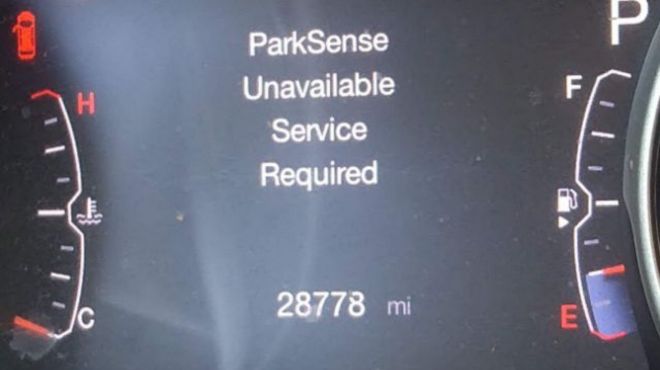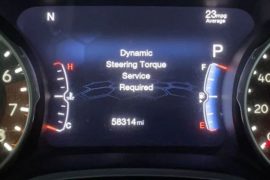The “ParkSense Unavailable Service Required” message appears on your Jeep screen when the system’s sensors are obstructed by debris, fall out of correct alignment, or stop working properly due to electrical malfunctions. Factors like aftermarket modifications, tire sensor interference signals, or even heavy snow buildup on the rear bumper can also trigger the warning light to illuminate unexpectedly.
You can typically restore functionality by thoroughly cleaning and realigning sensors, testing wiring connections, relocating spare tires, or simply restarting the vehicle’s electronics to reset any temporary glitches.

In this article, we’ll cover what causes this warning and – more importantly – provide some helpful tips to get your ParkSense system back up and running. Consider this your guide to outsmarting the frustrating “Unavailable Service Required” alert.
What Causes the “ParkSense Unavailable” Warning?
So you’re cautiously backing up, expecting those familiar beeping tones to alert you about the garbage cans you’re approaching. But instead…silence. Then the dashboard message pops up: “ParkSense Unavailable Service Required.” Ugh!
What gives? A few common culprits are likely to blame for sending that frustrating warning:
Sensor blocked by dirt, snow, debris
First, check the four sensors on your rear bumper. They could simply have some debris, dirt, snow or ice built up around them, preventing them from detecting objects. Think about where you last drove – was it on a mucky dirt road or in a snowy parking lot?
Give the sensors a wipe down with a soft damp cloth to clean them. Be gentle though! Rough handling can throw off their calibration.
Sensor Malfunctions
If the sensors seem clean but still aren’t working, moisture damage or corrosion over time may have led to malfunctions. After all, those sensors take a beating from road grim and extreme weather. Dust and dirt can also interfere with their ability to accurately measure distances.
Many Jeep owners in cold climates discover the sensors stop working properly once winter rolls around. The cold combined with wet slushy roads does a number on those delicate electronics.
Misaligned Sensors
Did you recently get rear-ended or have some body work done on your Jeep? Even small bumps and modifications in the rear can knock sensors out of alignment. They have to be perfectly positioned to give accurate readings, otherwise the ParkSense system gets confused.
Electrical shorts or damaged wiring
Frustrating electrical shorts or damaged wires in the ParkSense system can definitely disable it from functioning properly. After all, the sensors rely on receiving good electrical connections to power their object detection and alert features.
Inspect any wiring related to the sensors for exposed, cut or pinched sections. That includes the connector leads as well as insulation protecting the wires. Any nicks or tears in the protective coverings can allow moisture or dirt to cause a short.
If you recently installed an aftermarket backup camera or other accessories, check those wires too. Incorrect installations can inadvertently wreak havoc on existing electronics.
Interference from tire pressure monitoring system sensors
Here’s an unexpected glitch – the tire pressure monitoring system (TPMS) can sometimes interfere with ParkSense! The sensors affixed to your wheels emit radio signals that may disrupt operation of the rear sensors.
Try relocating your full-size spare tire from the rear to eliminate the TPMS sensor as the culprit. If the spare is mounted on the back door, the signal can be too close for comfort.
Environmental factors like cold weather condensation
Remember we mentioned earlier that cold, wet weather can damage the sensors? Well low temperatures and moisture intrusion can also impact the alarm tones and readout even if the sensors are fine.
On frigid winter days, wait a few minutes for the engine, sensors and display electronics to warm up before relying on ParkSense. The cold can make components sluggish to activate.
Aftermarket modifications impacting sensor positioning
Consider any modifications you’ve made on your Jeep like adding oversized tires, aftermarket bumpers, lifted suspensions or anything else that changes the factory configuration. Even small alterations can block sensors or throw off the carefully calibrated system.
Also see – ACC/FCW Unavailable Service Required: Causes and Fixes
How to Fix “ParkSense Unavailable” Issue?
Clean sensors thoroughly, use soft damp cloth
Alright, we’ve covered a whole lineup of usual suspects behind the “ParkSense Unavailable” warning. Now let’s get into the fun part – easy fixes to get the technology back on your side.
A good first step is giving the sensors a thorough cleaning with a soft damp cloth, making sure to wipe off any built-up dirt, debris or snow. Just be gentle during cleaning and avoid using any abrasive pads or materials. The sensors have delicate electronics inside that are precisely calibrated.
While cleaning, inspect for signs of physical damage too. Cracks, heavy scratching or severed connector wires indicate replacements may be needed.
Realign and reposition sensors after repairs/modifications
If you recently had body work done after an accident or modifications like lifting the chassis, verify all sensors are still properly aligned. Even half an inch off can confuse the system. Break out the measuring tape and owner’s manual to check positioning matches the factory specifications. Just a little re-adjustment can get things working again.
And don’t forget to test after any realigning – have a friend stand nearby while you slowly back up toward them. The beeping tones should sound when you reach typical distances.
Reduce condensation issues: allow engine to warm up before use
In cold or humid weather, condensation can form inside the ParkSense sensor housings when the temperature changes. Allowing your engine to fully warm up helps minimize condensation issues which can interfere with the internal electronics.
Few extra minutes warming your Jeep prevents skips in the sensors reading distances. Patience pays off with better ParkSense performance!
Test resistance of each sensor with multimeter
Grab a common multimeter from any auto parts store to test the electrical resistance across each of your rear sensors. Consult your owner’s manual for the factory resistance range specifications. Any sensors outside the range likely need professional replacement.
But don’t worry if you don’t know how to use a multimeter – your local dealer’s service department can handle measuring for you during diagnosis.
Manually check if sensors are making noise when backing up
Here’s a simple manual check – have an assistant stand near the rear of your Jeep while you switch the gearshift into Reverse and listen closely. Even if the ParkSense dashboard display stays dark, you should hear subtle clicks, tones or buzzing coming from each sensor as they send and receive ultrasonic signals.
If one or more sensors remain silent, there may be an electrical fault or alignment issue affecting that unit. Seek expert help pinpointing the problematic component.
Inspect wiring for any damage, repair if needed
While digging into ParkSense issues, be sure to inspect the system’s electrical wiring connections. Damage from pinching, cuts or corrosion can definitely cause trouble.
Carefully check the full length of wires leading to each corner sensor and to the central control module. Also examine places wires pass through holes in the body or chassis for signs of rubbing. Any spots with exposed copper require professional splicing and sealing to prevent future problems.
Electrical tape and heat-shrink tubing work magic to protect sensitive wires from further harm. Consider adding protective loom tubing over the entire sensor wiring harness if it’s exposed. Prevention is the best medicine!
Also see – Jeep Wrangler Automatic Transmission Shifting Problems: How to Fix?
Change position of spare tire to minimize interference
Here’s a quick fix to try with no tools required – move your spare tire to eliminate signal interference! The tire pressure monitoring sensor embedded in the spare can sometimes disrupt the ultrasonic waves from the ParkSense system.
Relocating the spare from a rear-mounted carrier down to the ground under the Jeep is an easy first step. You’d be surprised how getting that TPMS sensor lower or further away allows everything to play nicely together.
Reboot vehicle’s electrical system to reset electronics
Last but not least in your troubleshooting bag of tricks is the old “turn it off and back on again” mantra. Cycling power to the ParkSense system can reset any electron gremlins causing glitches.
Shut off the ignition, wait 15 seconds, and restart your Jeep. This forces all computers and sensors to reboot fresh. If you had any temporary electrical interference or faulty sensor readings, this can clean the slate.
Also see – Active Lane Management Unavailable Service Required: How to Fix?
When to Seek Professional Help
Alright, you went through all the troubleshooting – cleaned sensors, checked connections, moved spare tires – but still that pesky “ParkSense Unavailable” warning persists.
Now it’s time to let the professionals take over. If your testing reveals any physical damage or electrical faults in the sensors themselves, replacement is likely required. And any wiring repairs in the harness or control module are best left to experts.
While advanced diagnostics and soldering electrical components may seem intimidating, a seasoned technician can efficiently get components repaired or swapped. Your local dealership service department is best equipped to source original ParkSense system parts too.
It’s well worth the investment to have a fully functioning system versus risking further problems (or headaches) down the road!
The Perks of a Parking Helper
Convinced yet that fixing your ParkSense is valuable for more than just silencing that annoying dashboard alert? Restoring functionality pays dividends when it comes to safety, protecting your ride, and simply easing everyday driving duties.
ParkSense gives you confidence when maneuvering into tight spaces, acting as an indispensable co-pilot alerting you to objects otherwise lurking in blindspots. No more rolling down windows and craning your neck to check for obstacles!
And you can breathe easier knowing minor collisions from distraction or misjudgement of distance will be minimized. Those high-tech sensors are intuitive guardian angels not worth ignoring.
Lastly, don’t discount the simple convenience factor day-to-day. Effortless parallel parking is a modern marvel we’ve quickly gotten used to thanks to advances like ParkSense. Don’t suffer needlessly – get your system revived!
Dangers of Neglecting Warnings
On the flip side, ignoring ParkSense errors like “Unavailable Service Required” alerts leaves you flying blind. Backing up without sensing systems functioning properly heightens risks each time you shift into reverse.
Instead of prevention, you’re left hoping for dumb luck avoiding scrapes, dents, poles, fences and anything else lurking behind your Jeep. Costly body damage can rack up rapidly. Worse yet, collisions threaten injury to passengers or pedestrians.
And talk about annoying – that incessant beeping and warning symbol illuminating every time you start your Jeep would drive anyone crazy! Refusing to fix the issue just leads to headaches down the road.
ParkSense Restored!
Through our journey troubleshooting “ParkSense Unavailable” alerts, we’ve covered quite a bit of ground zeroing in on root causes like blocked sensors, electrical issues, interference factors, and more. Don’t worry about remembering every detail!
Here’s a quick recap of the most common culprits behind that cryptic warning message:
- Dirty sensors – Clean gently with a soft damp cloth
- Misaligned sensors – Re-position carefully after repairs
- Damaged wiring – Inspect and repair cuts, frays, corrosion
- Signal interference – Relocate spare tire away from sensors
- Environmental factors – Allow warmup to reduce condensation
The takeaway – this exasperating alert is well worth addressing promptly rather than ignoring. Restoring your ParkSense system pays dividends for added convenience and preventing expensive accidents.
Consider the solutions and tips we’ve covered as your guide to smarter, safer reversing thanks to a fully functioning set of ultrasonic eyes on the back of your Jeep. No blindspot left behind!
Now that you’ve got the insights needed to troubleshoot ParkSense problems like a pro, here’s wishing you smooth, graceful parking in all those tight spots life throws your way. Just don’t forget to thank your rear sensors once you’re neatly tucked into place!



